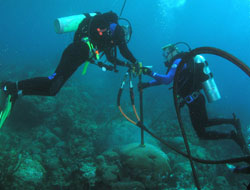You are here: Home › Ecosystems › Coral Reefs › Feature Stories › CSCOR-Sponsored National Coral Reef Institute Work on “Ancient Coral” Featured in Sun-Sentinel
CSCOR-sponsored National Coral Reef Institute Work on “Ancient Coral” Featured in Sun-Sentinel.

The CSCOR-sponsored National Coral Reef Institute (NCRI) at Nova Southeastern University was recently featured in an article by South Florida’s Sun-Sentinel newspaper. The article discusses NCRI's work on a large, 300 year old coral head that was discovered in the waters off of Hollywood, Florida. This unique finding offers NCRI scientists a rare opportunity to look into the past and learn about a multitude of topics including climate change and environmental stressors.
The work described by author David Fleshler in the article “A Coral's Clues,” serves as an excellent example of NCRI's ongoing collaboration and partnership efforts. The Broward County Environmental Protection Department was first to discover the coral, and reported the location immediately to researchers at NCRI. NCRI then worked with NOAA scientists to obtain the core. Soon after, NCRI researchers performed the chronological analysis, and began research on growth and associated history of the core. Initial analysis of the coral head not only yielded information to establish the coral’s age, but also provided over three centuries worth of historical data.
NCRI is currently working with researchers at the University of Miami, NOAA and USGS to conduct further chemical, isotope, and genetic analysis of the core sample in efforts to obtain information regarding trends in ocean temperature, the effects of sewage as well as greenhouse gas emissions on the health of the coral. Considering the coral was found off the heavily urbanized southeast region of Broward County, it is subject to multiple anthropogenic stressors, including stormwater runoff. It is hoped that future genetic analysis will lead to some interesting information on why this particular piece of coral is able to withstand such stressors when others of the same species have failed. For more information, please contact David Hilmer (301-713-3338 ext. 154 or David.Hilmer@noaa.gov). To view the article in its entirety, please visit online at http://www.nova.edu/ncri/news/a14.html.

